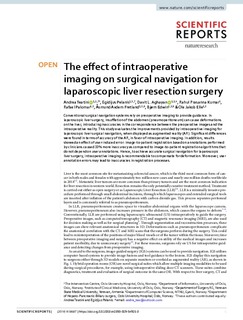| dc.contributor.author | Teatini, Andrea | |
| dc.contributor.author | Pelanis, Egidijus | |
| dc.contributor.author | Aghayan, Davit | |
| dc.contributor.author | Kumar, Rahul Prasanna | |
| dc.contributor.author | Palomar, Rafael | |
| dc.contributor.author | Fretland, Åsmund Avdem | |
| dc.contributor.author | Edwin, Bjørn | |
| dc.contributor.author | Elle, Ole Jacob | |
| dc.date.accessioned | 2020-01-23T07:54:48Z | |
| dc.date.available | 2020-01-23T07:54:48Z | |
| dc.date.created | 2020-01-09T10:36:09Z | |
| dc.date.issued | 2019 | |
| dc.identifier.citation | Scientific Reports. 2019, 9 | nb_NO |
| dc.identifier.issn | 2045-2322 | |
| dc.identifier.uri | http://hdl.handle.net/11250/2637556 | |
| dc.description.abstract | Conventional surgical navigation systems rely on preoperative imaging to provide guidance. In laparoscopic liver surgery, insufflation of the abdomen (pneumoperitoneum) can cause deformations on the liver, introducing inaccuracies in the correspondence between the preoperative images and the intraoperative reality. This study evaluates the improvements provided by intraoperative imaging for laparoscopic liver surgical navigation, when displayed as augmented reality (AR). Significant differences were found in terms of accuracy of the AR, in favor of intraoperative imaging. In addition, results showed an effect of user-induced error: image-to-patient registration based on annotations performed by clinicians caused 33% more inaccuracy as compared to image-to-patient registration algorithms that do not depend on user annotations. Hence, to achieve accurate surgical navigation for laparoscopic liver surgery, intraoperative imaging is recommendable to compensate for deformation. Moreover, user annotation errors may lead to inaccuracies in registration processes. | nb_NO |
| dc.language.iso | eng | nb_NO |
| dc.publisher | Nature Research | nb_NO |
| dc.rights | Navngivelse 4.0 Internasjonal | * |
| dc.rights.uri | http://creativecommons.org/licenses/by/4.0/deed.no | * |
| dc.title | The effect of intraoperative imaging on surgical navigation for laparoscopic liver resection surgery | nb_NO |
| dc.type | Journal article | nb_NO |
| dc.type | Peer reviewed | nb_NO |
| dc.description.version | publishedVersion | nb_NO |
| dc.source.volume | 9 | nb_NO |
| dc.source.journal | Scientific Reports | nb_NO |
| dc.identifier.doi | 10.1038/s41598-019-54915-3 | |
| dc.identifier.cristin | 1769078 | |
| dc.description.localcode | Open Access This article is licensed under a Creative Commons Attribution 4.0 International License, which permits use, sharing, adaptation, distribution and reproduction in any medium or format, as long as you give appropriate credit to the original author(s) and the source, provide a link to the Creative Commons license, and indicate if changes were made. The images or other third party material in this article are included in the article’s Creative Commons license, unless indicated otherwise in a credit line to the material. If material is not included in the article’s Creative Commons license and your intended use is not permitted by statutory regulation or exceeds the permitted use, you will need to obtain permission directly from the copyright holder. To view a copy of this license, visit http://creativecommons.org/licenses/by/4.0/. | nb_NO |
| cristin.unitcode | 194,63,10,0 | |
| cristin.unitname | Institutt for datateknologi og informatikk | |
| cristin.ispublished | true | |
| cristin.fulltext | original | |
| cristin.qualitycode | 1 | |

